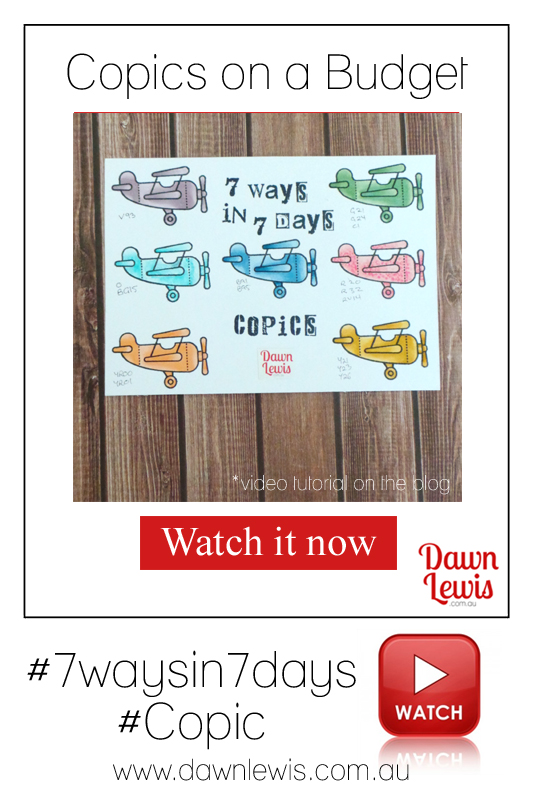Hello … welcome to The Craft Room Podcast, and if this is your first time listening, a special welcome to you. Firstly, I would also like to apologise for my husky voice … I’ve had a bit of a nasty cold virus for the past couple of weeks, so please bear with me.
In the last episode we talked a little about what Copic markers are, the difference between the styles of marker, the codes and 0 colourless blender. If you haven’t heard that episode yet, I’ll link to that in the show notes. I really did want to cover everything in one episode, but pretty soon I realised it would be far too long, and a bit of information overload, hence why we have this 2 part Copic Q&A series.
If you missed it, you can catch the previous episode HERE
Today let’s tackle another of the most frequently asked questions regarding Copic markers.
“I can’t afford Copic markers. Are the cheap alcohol markers just as good or the same?”.
I am always interested in seeing the different answers, because we can only answer a question like that from our own research and personal experience. I’ve seen people answer with a simple Yes or No … but I believe there really is more to this question. The person asking it doesn’t usually want a simple yes or no answer. What they may be seeking is information to help them make an informed purchase. They need the WHY. Making a decision about which brand of alcohol markers to purchase hinges on a lot of variables, and there are some questions you can ask yourself (or the person asking the original question) to help with that decision making process.
What type of colouring do you like to do? Or do you want to do?
Why are you thinking of investing in alcohol markers?
What are you hoping to use them for? Cards, planner, art?
Do you already have some alcohol markers?
Do you want to invest in a good quality marker to last a lifetime or are you looking to dabble for fun right now?
Not all alcohol markers are designed for lifetime use. Some are single use, some are refillable. Some have fixed nibs, some offer replacement nibs. Few have the same colour range as Copic. Some offer sets, designed to blend well, others have very few colours that blend. The ink formula is going to differ from band to brand … some blend well and others do not.
So if the person asking the question really wants those gorgeous seamless blends that Copic markers are known for, they may come close with some brands, but rarely with the single use markers that are super cheap.
If you just want to play and aren’t worried about smooth blends, then the less expensive markers will likely meet your needs.
If you want to use alcohol markers in your planner, you should be aware that they will soak through the page, and depending on your paper thickness, may soak through one or more pages behind that. The best option for using alcohol markers in planners is to colour on stickers then add them to the page.
If you really aren’t sure if you’re going to enjoy using them, I highly recommend taking a class with a Certified Copic Instructor. Yes … anybody can teach Copic colouring classes, but there are a LOT of Copic myths out there. Without realising it, or even meaning to, an uncertified instructor could be giving incorrect information. Certified Instructors go through an intensive in-person course run by the Copic distribution company in their country, and are provided with reference materials and hands-on instruction. They know their stuff. By taking a lesson, you’re going to learn about all the things the markers can do, you get hands on practice, can ask questions, and your instructor can help you refine your colouring technique for best results. You get to try it out, and after a couple of hours you will know if you love this enough to continue learning and starting building your Copic collection.
Let’s talk about cost vs value for a minute. The price of markers and re-inkers varies from retailer to retailer, but as an example, a Sketch marker is currently $8.95 in my store. Assuming you do regular marker maintenance, and don’t drop, step on or damage your marker, it should last you a lifetime. When it runs dry, you can purchase a re-inker, which costs around $12. From that one bottle, you can refill you sketch marker at least 13 times. That’s less than $1 per refill, which is certainly cheaper than buying a new marker each time it runs dry. Sure … it’s a bigger outlay upfront, so the cost seems high. But if you are like me, and use your markers a lot, and plan to use them for decades to come, the value is better.
If you opt for a cheaper marker that can’t be refilled, let’s say $4 each … the cost over the initial purchase and 13 subsequent purchases, is significantly higher.
Let’s do the math
1 Sketch marker + 1 re-inker gives you 14 full barrels of ink for $20.95
Assuming the cheaper marker has the same barrel capacity, multiply that $4 x 14 and the cost is $56.00
That’s a whopping $35.05 extra to use cheap non-refillable markers for the same amount of time.
This leads into the environmental impact this decision can also have. The sketch marker stays with you, for decades, and the re-inker container is recyclable. So in those 14 full barrel uses, one small container is recycled, whereas the single use markers all end up in landfill, as they are not recyclable.
Each of us have different priorities, different values, different space available and different budgets … and these are going to impact us in our decision making process. These things are also not etched in stone … our circumstances change … priorities change … budgets change … we change. And so the decisions we make now regarding our alcohol marker purchasing and use can also change. If your budget doesn’t allow it now, it may in the future, so don’t feel like this is a one-off decision you need to make and be stuck with.
Now … let’s talk about Copic re-inkers. If the expense of reinkers is the one thing keeping you from choosing Copic markers, did you know that some Copic stockists offer a re-inking service? This is something that I have just launched as part of my store’s Copic services, because I understand that re-inkers are a big outlay. Sure, per refill it’s a little more expensive to have someone else re-ink than doing it yourself, but that’s because you’re paying that tiny bit extra to have someone else do that task for you. But let’s be honest … if you have 10 markers that have all run dry at once, having a re-inking service fill those for you is going to cost less than purchasing all 10 re-inkers. A re-inking service is a good stop-gap until you’re ready to buy the refill bottles yourself.
CLICK HERE to find my re-inking service, and on that page there are lots of pro tips for marker maintenance.
Over the past ten years I have tried a few other styles of alcohol marker, but I always come back to Copic. I started small, I shopped around, I put them on my birthday and Christmas wish lists, and I kept a chart so I didn’t double up on my purhcases. It has taken me exactly ten years to complete my collection, and this leads me to another common question (actually, it’s more like two questions).
“Which colours should I start with?”
“Do I need all the colours?”
In short you do not NEED all the colours, even though you may want them all. There are some colours in my collection that I have never used, and some I rarely use. I find myself going back to my favourite combos time and tiem again. Of course, there are exceptions to that rule, and if your professional makes use of the full collection, then go for it!
As for the ideal colours to start with, well that depends entirely on what you will be colour, and your personal taste in colours. If you want to achieve a smooth colour blend from light to dark, ideally you would start with 3 markers in a natural colour blending family. What that means is … you need to take note of the marker codes. The letter(s) should be the same, the first number should be the same and the last numbers should ideally be 1-3 numbers apart. One of my most used combinations is E50, E51 and E53. They are all E50’s, very close together. They blend really well, and I use this combo for skin tones and cream coloured things (like sails, clothing, buildings, etc). E50 was the first re-inker I bought. Because I used this combo so often colouring people stamps, and being the palest colour, it covered the entire area, it was the first marker to run dry. I was also able to get this combo in Ciao markers, which was cheaper.
When you are choosing your starter colours, think about how versatile they are going to be. Can you colour different types of things with this colour combination? Do you like using bright colours or muted tones? If you’re all about the brights, start with those. If you enjoy neutrals, start with those. If your Copic stockist doesn’t have the colours you want, ask if they are willing to order them in for you. I offer a pre-order service and am happy to order in specific markers, and love helping people choose colours that will work with their existing collection, or to expand into a new colour family.
resource that I highly recommend is the Sandy Allnock Copic hex chart. It’s a digital download, very affordable, and honestly, it has helped me pull together colour combos I might never have considered before. I will ink to the Hex chart in the show notes, and I don’t get a kick-back or affiliate payments … I just genuinely like it as a useful tool. A quick Google image search will bring up a completed hex chart, which is not only a beautiful sight, but it can give you an idea of which colour combos you might like to try next.
CLICK HERE to find the Sandy Allnock Copic Hex Chart
Another great resource is Pinterest. I will link to my Copic board on Pinterest, as there are some amazing colour combo ideas in there. Create your own Copic board and use it as your personal Copic reference guide.
CLICK HERE to find my Copic Pinterest board
I know some of you might be wishing I could just give you a list of colours to start with, but what’s right for one person won’t be right for another. What I can do is show some of my favourite combos, and hopefully you’ll find something you like.
If you have a burning Copic question that I haven’t covered in these episodes, I would love to hear from you. What else would you like to know?


